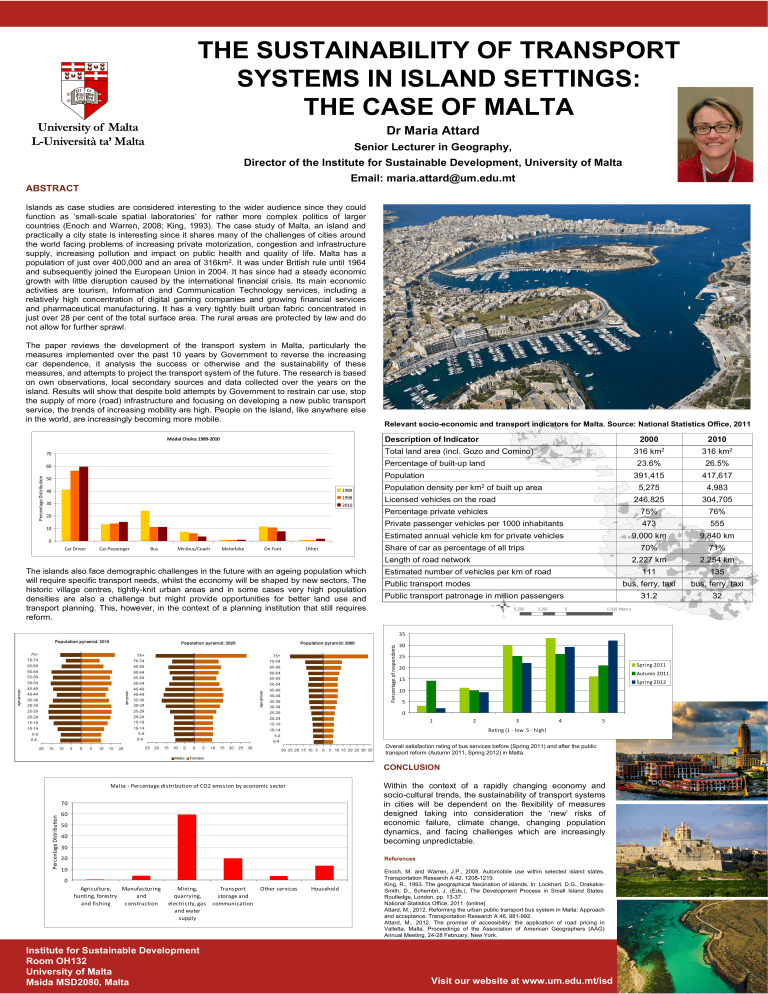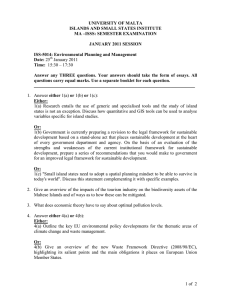THE SUSTAINABILITY OF TRANSPORT SYSTEMS IN ISLAND SETTINGS: THE CASE OF MALTA

40
30
20
10
0
70
60
50
THE SUSTAINABILITY OF TRANSPORT
SYSTEMS IN ISLAND SETTINGS:
THE CASE OF MALTA
Dr Maria Attard
Senior Lecturer in Geography,
Director of the Institute for Sustainable Development, University of Malta
Email: maria.attard@um.edu.mt
ABSTRACT
Islands as case studies are considered interesting to the wider audience since they could function as ‘small-scale spatial laboratories’ for rather more complex politics of larger countries (Enoch and Warren, 2008; King, 1993). The case study of Malta, an island and practically a city state is interesting since it shares many of the challenges of cities around the world facing problems of increasing private motorization, congestion and infrastructure supply, increasing pollution and impact on public health and quality of life. Malta has a population of just over 400,000 and an area of 316km 2 . It was under British rule until 1964 and subsequently joined the European Union in 2004. It has since had a steady economic growth with little disruption caused by the international financial crisis. Its main economic activities are tourism, Information and Communication Technology services, including a relatively high concentration of digital gaming companies and growing financial services and pharmaceutical manufacturing. It has a very tightly built urban fabric concentrated in just over 28 per cent of the total surface area. The rural areas are protected by law and do not allow for further sprawl.
The paper reviews the development of the transport system in Malta, particularly the measures implemented over the past 10 years by Government to reverse the increasing car dependence, it analysis the success or otherwise and the sustainability of these measures, and attempts to project the transport system of the future. The research is based on own observations, local secondary sources and data collected over the years on the island. Results will show that despite bold attempts by Government to restrain car use, stop the supply of more (road) infrastructure and focusing on developing a new public transport service, the trends of increasing mobility are high. People on the island, like anywhere else in the world, are increasingly becoming more mobile.
Car Driver Car Passenger Bus
Modal Choice 1989-2010
Minibus/Coach Motorbike On Foot Other
1989
1998
2010
The islands also face demographic challenges in the future with an ageing population which will require specific transport needs, whilst the economy will be shaped by new sectors. The historic village centres, tightly-knit urban areas and in some cases very high population densities are also a challenge but might provide opportunities for better land use and transport planning. This, however, in the context of a planning institution that still requires reform.
Relevant socio-economic and transport indicators for Malta. Source: National Statistics Office, 2011
Description of Indicator
Total land area (incl. Gozo and Comino)
Percentage of built-up land
Population
Population density per km 2 of built up area
Licensed vehicles on the road
Percentage private vehicles
Private passenger vehicles per 1000 inhabitants
Estimated annual vehicle km for private vehicles
Share of car as percentage of all trips
Length of road network
Estimated number of vehicles per km of road
Public transport modes
Public transport patronage in million passengers
2000
316 km
23.6%
391,415
5,275
246,825
75%
473
9,000 km
70%
2,227 km
111 bus, ferry, taxi
31.2
2
2010
316 km 2
26.5%
417,617
4,983
304,705
76%
555
9,840 km
71%
2,254 km
135 bus, ferry, taxi
32
Malta - Percentage distribution of CO2 emssion by economic sector
70
60
50
40
30
20
10
0
Agriculture, hunting, forestry and fishing
Manufacturing and construction
Mining, quarrying, electricity, gas and water supply
Transport storage and communication
Other services Household
35
30
25
20
15
10
5
0
1 2 3
Rating (1 - low 5 - high)
4 5
Overall satisfaction rating of bus services before (Spring 2011) and after the public transport reform (Autumn 2011, Spring 2012) in Malta.
CONCLUSION
Within the context of a rapidly changing economy and socio-cultural trends, the sustainability of transport systems in cities will be dependent on the flexibility of measures designed taking into consideration the ‘new’ risks of economic failure, climate change, changing population dynamics, and facing challenges which are increasingly becoming unpredictable.
References
Enoch, M. and Warren, J.P., 2008. Automobile use within selected island states.
Transportation Research A 42, 1208-1219.
King, R., 1993. The geographical fascination of islands. In: Lockhart, D.G., Drakakis-
Smith, D., Schembri, J. (Eds.), The Development Process in Small Island States.
Routledge, London, pp. 13-37.
National Statistics Office, 2011. [online]
Attard, M., 2012. Reforming the urban public transport bus system in Malta: Approach and acceptance. Transportation Research A 46, 981-992.
Attard, M., 2012. The promise of accessibility: the application of road pricing in
Valletta, Malta. Proceedings of the Association of American Geographers (AAG)
Annual Meeting, 24-28 February, New York.
Spring 2011
Autumn 2011
Spring 2012



